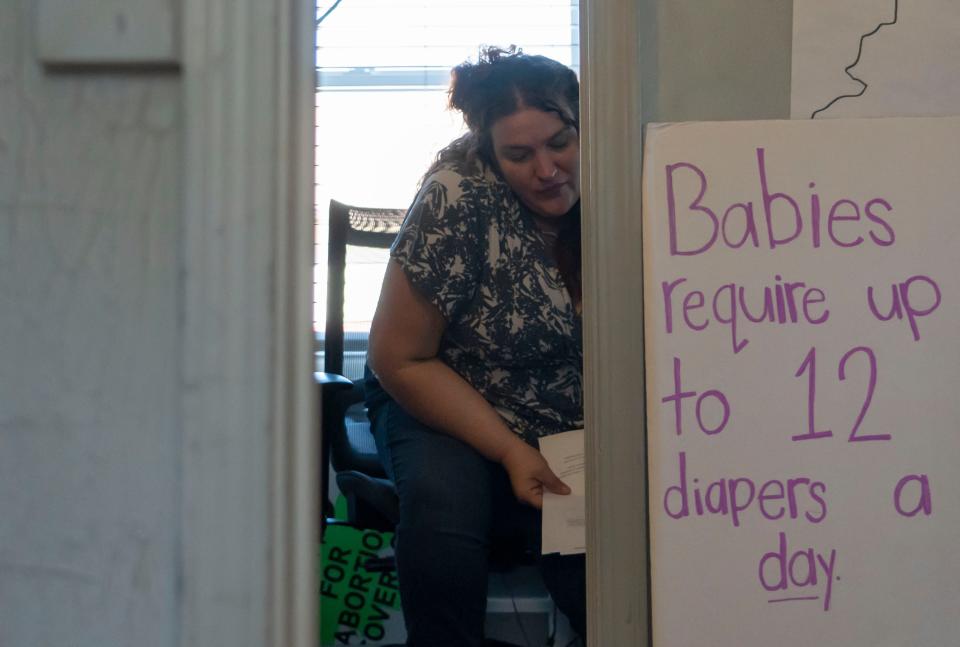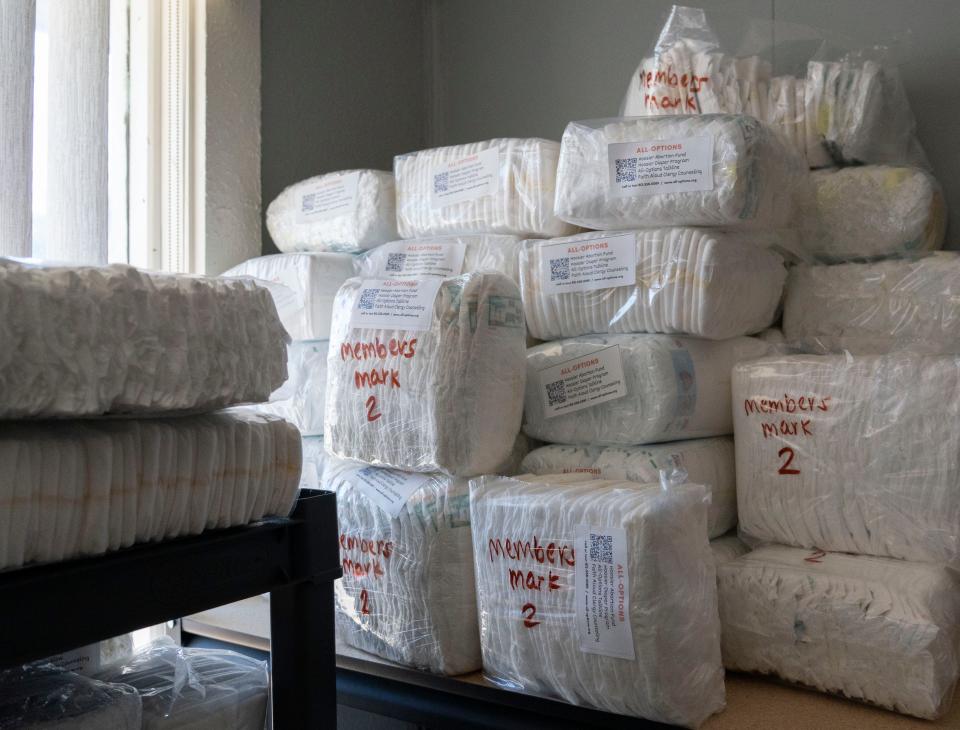'Everything is not fine': Diaper program helps Indiana families amid tumultuous economy
On Mondays, the chaos doesn't stop.
Every few minutes, Jess Marchbank’s email lights up with another order. She prints out the sheet quickly and runs into the next room to attach it to a stuffed bag of diapers, piled along the walls of the Bloomington house.
“It’s like this every Monday,” said Marchbank, the state programs manager of All-Options Pregnancy Resource Center, said.
Print orders. Pack diapers. Send them out the door.
Indiana’s legislature cut the state’s sales tax on diapers over the summer but diaper access advocates and consumers say their resources are swamped. Mondays are busier than they ever were before at the center.
Indiana politics:House, Senate vote 'yes' on $200 taxpayer refunds, support services
In August, All Options’ Hoosier Diaper Program gave out more than 20,000 diapers through its pick-up service and nonprofit partners. It’s the most they have dispersed in recent memory, said Marchbank, who started at the resource center in 2017.
Rising costs due to inflation have families paying more for everything. Diapers are no exception.
All-Options and other nonprofits across Indiana are aiding low-income families while navigating their highest demand in a decade as limited assistance from state and federal programs burdens them further.
Hoosier diaper programs help struggling families get by
In early October, Bria Parker’s due date was fast approaching. Her family would soon grow to four children.
Her husband and their children moved back to Bloomington from Georgia over the summer. Between the move and their recent nuptials, budgeting was crucial.
As Parker prepared to give birth, she believed no business would hire her, even if they can’t discriminate by law. Her family was relying on one income until she could go back to work postpartum.
"If it came down to like gas or diapers, obviously I have to get diapers, but I need gas sometimes, too, so it just helps all the in-between times," Parker said.
Outside Marchbank’s office, there’s a sign: Babies require up to 12 diapers a day.
On average, a pack of size one Pampers Swaddlers 96-count diapers costs $28.49 at box stores like Target in Indiana. The price went up $1 since late July despite the tax break.
For a family with one child, that pack could last a little over a week, pending no issues.
With one child still in diapers and another on the way, Parker arrived at All-Options to pick up her bag of diapers with no judgment.
"I want to make sure my kids get what they need, too," Parker said.
Many households who do not have transportation to larger store chains buy diapers at neighborhood dollar stores, gas stations or pharmacies at a significant markup, said Ashley Burns, who runs the Indiana Diaper Bank.
That “poverty tax” is concerning, she said.
Indianapolis-based Indiana Diaper Bank has distributed more than 743,000 diapers this year through its partners, the most in its history, Burns said. That's about 60,000 diapers a month, she said. Plus, there's a waitlist of nine partners. The demand puts pressure on Burns to expand the bank's employees and resources to keep up.
"We're not going to be able to maintain that without growth at some point," Burns said. "But right now, we're spending so much money on diapers and wipes that makes it really difficult to kind of increase."

A day's worth of diapers: 'People don't realize' how many that is
Every week, Sandy Daffron drives to the diaper bank and Mother Hubbard's Cupboard in Bloomington, one of the bank's partners, to pick up a bag of diapers for her two granddaughters.
"People don't realize even the five to seven or whatever they give out, that is a day's worth of diapers," Daffron said.
And it's a significant amount of money she can spend elsewhere, making her grandchildren's lives better with extra food, better clothes, more books or daytime activities, Daffron, 54, of Bloomington, said.
People who seek help from the Bloomington-based program do not fall into any particular category of low-income or one-parent households, Marchbank said. Many of them need diapers for a short time; others need them continually.
It makes an impact for everyone, she said.
But the need is much higher than previous years, particularly since the pandemic, Cindy Chavez from Pantry 279 said.
The food bank, based in Ellettsville, Indiana, serves about 8,000 people. The bank provides seven diapers per family each week and about 1,000 children are served a month.
“Everything is not fine and dandy,” Chavez said. “The prices of everything are skyrocketing.”
Chavez and Marchbank met on Facebook during a late-night chat about what their banks were facing. They drew comparisons and contemplated what comes next as the nonprofits aid low-income families in crisis.
Pantry 279, which started in 2015, has reached the highest numbers on record in its history in the last three months. Chavez said the state leaves it to food pantries and other nonprofits to combat poverty, and legislators tend to look the other way.
Government aid programs often don't cover diapers
Most government assistance for low-income households does not extend to diapers.
Hoosier families who are on the Special Supplemental Foods Program for Women, Infants and Children, or WIC, in addition to the Supplemental Nutrition Assistance Program, or SNAP, are limited to food assistance, so they cannot purchase diapers under the programs.
The Temporary Assistance for Needy Families program, TANF, allows for benefits to be used on diapers or wipes but TANF’s reach has dwindled in the last two decades. Nationwide, only 21 percent of families living below the federal poverty level receive cash assistance through the program.
In Indiana, TANF serves a lower percentage of children in poverty than all but six states, according to the Center on Budget and Policy Priorities.
In some instances, the Indiana Diaper Bank has watched families struggle to secure child care because they don't have enough diapers, Burns said.
Many child care and day care programs do not supply diapers, so families must provide a minimum number of diapers depending on the length of time the child will be there. If parents don't have enough diapers, then they can’t drop off their child and go to work, Burns said.
Plus, there are health risks that can occur if an infant’s diaper is not changed on a regular schedule or when soiled, according to the American Academy of Pediatrics. Diapers that are wet or filled with a bowel movement can rub up against a baby’s skin and cause diaper rash or infection.

Diaper advocates focus on statewide change
As a means to advocate for their growing client base, diaper banks across Indiana have formed a coalition with sights set on January’s legislative session.
“We know that we need to kind of come together to make sure Indiana as a whole is covered,” Burns said.
The coalition has compiled research and soon will have priorities to lobby and share how immensely the need has grown.
“Food is a necessity, but we really want diapers and wipes to be classified as a necessity in Indiana,” Burns said.
Diaper distribution has continued to be brisk in the months since Hoosier Diaper Bank's record-setting August. In September, the bank distributed more than 33,000 diapers, returning to about 20,000 in October.
For now, Marchbank and other banks continue to serve that demand, for Bloomington and areas beyond.
As orders come in, she also packs up boxes to ship to a couple dozen families across the state, from Evansville to Gary. Mothers who went through the center's abortion fund are sent a box every week, and she expects that need to grow, too.
"The system has taught them to have guilt, the welfare system, food stamps, they've been taught that they have to like scrape and scrounge," Marchbank said. "It's a different experience for them when they come in here."
Where to get diapers for those in need
For assistance receiving diapers, go to www.indianadiaperbank.org/get-diapers.
To donate to the diaper banks, visit www.indianadiaperbank.org/give-diapers and alloptionsprc.org/diaper-program/#donate.
Contact IndyStar general assignment reporter Rachel Fradette at rfradette@gannett.com or follow her on Twitter: @Rachel_Fradette.
This article originally appeared on Indianapolis Star: Diaper program helps Indiana families amid tumultuous economy

